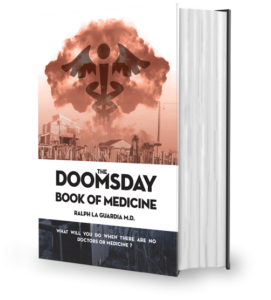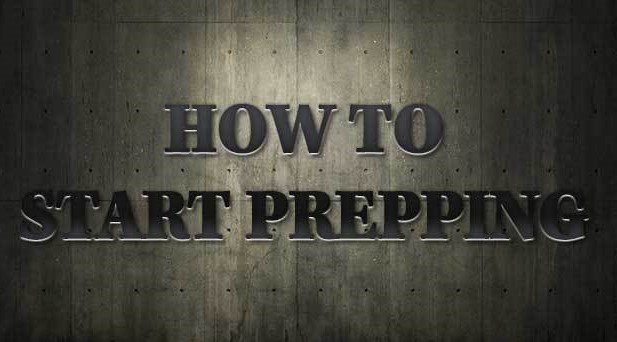How to Start Prepping
I believe that each of us has an inner voice. Call it what you will; instinct, hunch, feeling, foresight, or intuition they are all the same. It is a compelling force within us that we feel on an almost imperceptible level when you are quiet and your mind starts to ponder things you normally don’t give a second thought. This inner voice or instinct might be ignored or blamed away on bad tacos but for me and a lot of other people out there, our inner voice is telling us that we need to start getting prepared.
For me, my inner voice or ‘gut feeling’ as I typically call it started acting up around 2007. I don’t know why exactly and I haven’t over-analyzed it, to be honest. For me, I simply started feeling like I needed to take steps to prepare my family. There wasn’t a specific event I was worried about, just a general feeling, perhaps brought on by some realization of how fragile our society is. It was around this time that I really began to research how to start prepping and the journey I started back in 2007 continues to this day.

It’s official. This is now the prepper’s “go to book” saving them time and money on costly doctor visits. Details and how to get your copy here
If you are new to prepping, you must have millions of questions. I know I did and in the beginning, I scoured the internet for prepping websites, survival books and information from a wide array of sources that led me to a lot of insights and some great recommendations. I try to share what I have learned on the Final Prepper every day but even for me, there is no finish line. I am still working on prepping just like millions of other people. Today I want to share some advice for the person who is beginning their own journey and has questions on how to start prepping.
Do you know why you want to start prepping?
Prepping is a word that has only fairly recently become known around the world and it is usually associated with a negative connotation. TV shows like Doomsday Preppers and Doomsday Castle have both helped and hurt the idea of prepping in various degrees but I believe overall most people see the benefits of Prepping and can separate the bizarre actions of some from the common-sense process of prepping itself. Prepping to me is simply taking steps to prepare yourself and your family to better weather disasters. Why do we need to do anything in the first place? Isn’t that what the police and the fire department and government are for?
If you are here on this website, I am sure the answer to that question is obvious. If you have paid any attention to the events of just the last few years there are numerous examples of disasters that caught people off guard where neither the police, nor the National Guard, nor FEMA were able to help in a way that was fast and effective enough to save everyone or to end suffering. The cold hard truth is that in a disaster situation, you are better off relying on yourself than anyone else. Police can become overwhelmed, bureaucracies always have more important things to worry about and the needs of the individual (you) are not first on the priority list. In short, when something bad happens, you need a plan to deal with events if help doesn’t arrive. Relying on anyone in a professional capacity to save you is foolish and it can get you killed. You know that its time for you to get started prepping.

This book offers real-life solutions for the average person. That’s where the power lies. Get you copy of The Doomsday Book Of Medicine here
Start with the basics of getting prepared
There are many types of disasters that can strike. You only have to look at the news to see earthquakes, fires, riots, mudslides, hurricanes, wars, drought and the list goes on and on. Some people want to prepare for a specific event like a tornado and at first, that may seem like the most logical place to start, but what if you are prepared for a tornado and a flood comes instead? What if you are worried about a forest fire, but there is an earthquake? What if you are all set for a hurricane, but an EMP wipes out the electric grid?
There are things you can do to prepare for any event and I recommend you start with these 4 basic necessities. These 4 things are needed for life no matter what happens and if you take care of the four essentials, you will be ahead of 98% of the population.
Food – It’s very simple to know what you need. You need to store as much food as your family needs to eat for the duration of any disaster. Ideally, this would be food that doesn’t require refrigeration like canned or dehydrated food. If your budget allows you to purchase freeze-dried food, this is the simplest option and you can easily store several months’ worth of food under your bed in nice plastic containers. Even though it is the easiest, it isn’t the cheapest and a wiser strategy is to slowly just buy more of what your family already eats. This way, with a good rotation system you always have an abundance of fresh food your family likes. The freeze-dried food is pretty decent, but nothing like fresh food.

This Book Is The Noah’s Ark Of Prepping And It’s Making Americans Healthier by The Day. Details Here
Water – Another easy one. Water is necessary for life and you need a gallon per day for each family member. If you have 4 people in your house you would need 120 gallons of water to last a month. Ideally, you would back this up with a good filtration system like a Big Berkey water filter. Don’t believe you need that much water? Just look at the residents of Charleston WV a few months back or more recently Toledo who were told not to drink their water for weeks. Could you wait that out? Store water now while you have it and it’s plentiful.
Shelter – This is simply a way to keep out of the elements. If you have a home and it isn’t blown away you have shelter, but what if the power is off in the summer or the heat is out in the winter. Make sure you have plans to keep warm and cool. Sleeping bags work great in the winter, but summer there are fewer options. Unless you want to build your own swamp cooler.
Security – Disasters bring out the worst in people, but it doesn’t take a disaster to bring violence to your town. Just recently riots broke out over the shooting death of a teen. Riots break out all the time over sports games. Imagine if the power is out and the grocery store shelves are bare and people are hungry. Make sure you have a way to protect your family from people who either want what you have or simply want to burn and destroy things. I recommend legal firearms for responsible adults.
Research additional topics
What is your learning style? I guess more accurately, what can you use for motivation or ideas? I have been able to pull ideas out of a lot of different places. At the beginning as I was learning how to start prepping, I frequented numerous prepping websites and we have a great list of prepper sites on our resources page. Let me know if you’re interested.
I also bought books. The Doomsday Book of Medicine is the most complete medical guide ever written for non-medical people, it is also a manual that you can use to keep your body vigorously healthy and disease-free. No other book on the market today will teach you all of this, as well as how to make your own wound care solutions, saline solutions, eye irrigant, natural insect repellent, sunscreen, hydrating fluids, and even toothpaste. There has never been a book like this, so easy to read and so full of life saving medical information that cannot be found anywhere else.
Movies are another source of ideas and inspiration although you do have to have a certain tolerance or affection for the end of the world movies. I love them but my wife isn’t a big fan so I have to judiciously watch these. If you are looking for a good prepper movie, you can try the Best Prepper movie list and see if you can find something you haven’t seen before. I have even found movies do a better job of convincing people to prepare in some cases than all the factual arguments you can muster.
What Next?
Once you have the basics under control, there are tons of other areas where you can specialize for lack of a better word. The pages of the Final Prepper are filled with information around various threats, methods and strategies and all the pages are searchable and downloadable. You can learn about how to pack your bug out bags, vehicle survival kits and even prepper gear reviews. If you have any questions, just comment in the articles and I am sure someone will help you out with ideas and share their experience. Good luck on your journey and keep listening to that inner voice.
Other self-sufficiency and preparedness solutions recommended for you:
Healthy Soil + Healthy Plants = Healthy You
The vital self-sufficiency lessons our great grand-fathers left us
Knowledge to survive any medical crisis situation
Liberal’s hidden agenda: more than just your guns
Build yourself the only unlimited water source you’ll ever need
4 Important Forgotten Skills used by our Ancestors that can help you in any crisis
Secure your privacy in just 10 simple steps
I believe that each of us has an inner voice. Call it what you will; instinct, hunch, feeling, foresight, or intuition they are all the same. It is a compelling

